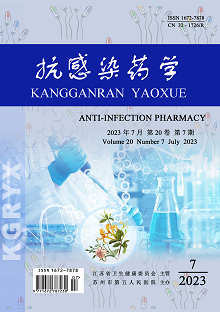WANG Min-yuan, WANG Biao, WU Qian-hong
Objective: To analyze the detection situation of Gram-negative bacteria and their characteristics of drug resistance changes in patients with pulmonary tuberculosis complicated with lower respiratory tract infection in a hospital from 2019 to 2022, so as to provide reference for the prevention and treatment of lower respiratory tract infection in patients with pulmonary tuberculosis. Methods: A total of 10 790 respiratory specimens such as sputum, alveolar lavage fluid, and throat swab from patients with pulmonary tuberculosis complicated with lower respiratory tract infection admitted to Shaanxi Provincial Tuberculosis Prevention and Control Hospital from January 2019 to December 2022 were collected as research data. The microbial cultivation and drug susceptibility test were conducted to analyze the detection situation of Gram-negative bacteria in patients' specimens and their characteristics of drug resistance changes. Results: 1 384 strains of Gram-negative bacteria were cultured and isolated from 10 790 specimens (with a total detection rate of 12.83%) in total, among which the top five strains were Escherichia coli (284 strains, 20.52%), Klebsiella pneumoniae (279 strains, 20.16%), Pseudomonas aeruginosa (251 strains, 18.14%), Acinetobacter baumannii (107 strains, 7.73%) and Stenotrophomonas maltophilia (81 strains, 5.85%); through the multidrug resistance test, a total of 204 extended-spectrum β-lactamase-producing strains (including 134 strains of Escherichia coli, 57 strains of Klebsiella pneumoniae, and 13 strains of Klebsiella oxytoca), and 55 carbapenem-resistant strains (including 22 strains of Pseudomonas aeruginosa, 21 strains of Acinetobacter baumannii, and 12 strains of Klebsiella pneumoniae) were detected. The drug susceptibility test results showed that the resistance rates of Escherichia coli to imipenem, meropenem, cefoperazone-sulbactam sodium, piperacillin-tazobactam sodium, and amikacin were always low (less than 10.00%) in 4 years; the resistance rates of Klebsiella pneumoniae to imipenem and meropenem were always low (less than 10.00%), while its resistance rates to cefazolin, cefuroxime, ceftazidime, ceftriaxone, ciprofloxacin, compound sulfamethoxazole, and chloramphenicol showed an upward trend (P<0.05); the resistance rates of Pseudomonas aeruginosa to imipenem, meropenem, piperacillin-tazobactam sodium, and amikacin were always low (less than 10.00%), while its resistance rates to gentamicin and tobramycin showed a downward trend (P<0.05); the resistance rate of Pseudomonas aeruginosa to minocycline was always 0.00%, and its resistance rates to ticarcillin-clavulanate potassium, piperacillin-tazobactam sodium, ceftazidime, meropenem, amikacin, gentamicin, ciprofloxacin, and levofloxacin showed an upward trend (P<0.05). Conclusion: Gram-negative bacteria detected in patients with pulmonary tuberculosis complicated with lower respiratory tract infection in the hospital are mainly Escherichia coli, Klebsiella pneumoniae, Pseudomonas aeruginosa and Acinetobacter baumannii, and most of them have strong drug resistance. Clinically, it is necessary to strengthen the pathogenic surveillance continuously in order to guide the rational use of antibacterial drugs and reduce the occurrence of bacterial resistance.
